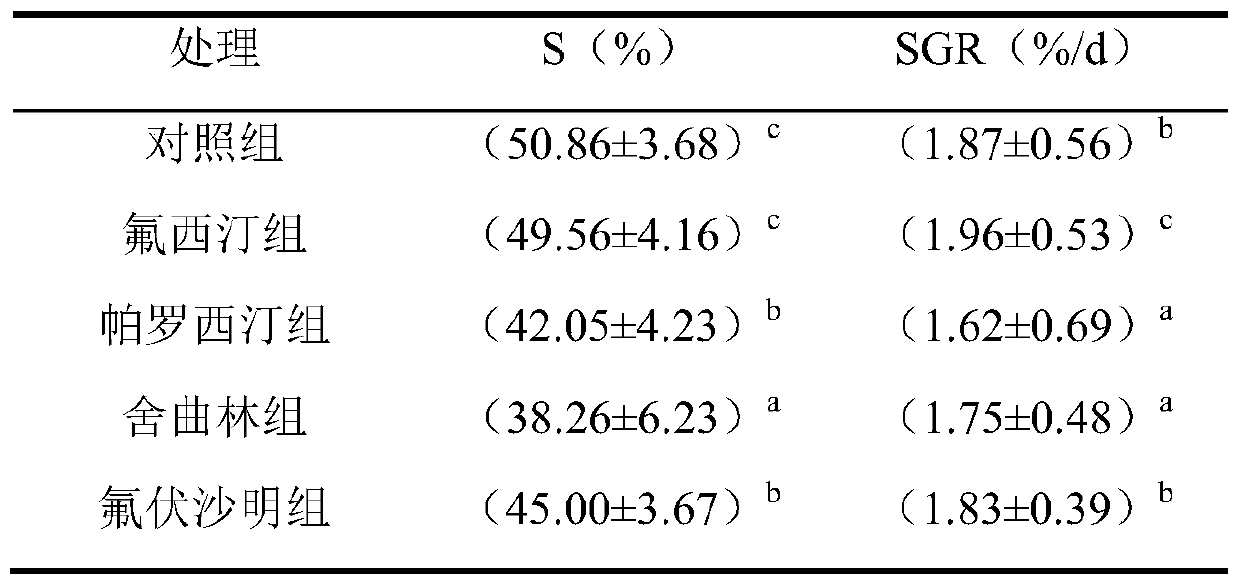Method for breeding marsupenaeus japonicas by fluoxetine
A technology of using fluoxetine and prawns is applied in the field of cultivating Japanese prawns using fluoxetine, which can solve the problems of reduced survival rate, more residual bait, and inability of shrimp to inhabit, so as to improve the survival rate and weight gain rate, save manpower and Material resources, the effect of reducing shrimp disease
- Summary
- Abstract
- Description
- Claims
- Application Information
AI Technical Summary
Problems solved by technology
Method used
Image
Examples
Embodiment 1
[0039] Effect of embodiment 1 different photoperiods on the growth of Penaeus japonicus
[0040] The body length of Penaeus japonicus used in the selection experiment was (1.930±0.217) cm, and the initial weight was (0.064±0.020) g. Four different light groups were set up in the experiment: total darkness (D), full light (L), light:dark=10L:14D and light:dark=14L:10D, and all treatment groups were set in 3 parallels. During the experiment period, fresh Artemia japonicum was fed to the prawns. The daily feeding amount was 10-15% of the body weight of the prawns. The feeding was carried out at 8:00 and 17:00 every day, and the ratio of feeding in the morning: evening 3:7, and then weigh the weight of Penaeus japonicus after 2 months of breeding, and calculate the specific weight gain rate and survival rate.
[0041] The experimental results are shown in Table 1. With the prolongation of the light time, the survival rate (S), specific growth rate (SGR) and molting rate (MF) of Pen...
Embodiment 2
[0045] Effect of different drugs on the growth of Penaeus japonicus in embodiment 2 bait
[0046] 1. Effects of different drugs on the growth of Penaeus japonicus
[0047] The body length of Penaeus japonicus used in the selection experiment was (2.48±0.28) cm, and the initial weight was (0.23±0.08) g. The experiment set up 4 different drug feeding groups (fluoxetine, paroxetine, sertraline and fluvoxamine are neuroleptic drugs) and a control group, in which the control group was sanded, and the drug feeding group was not sanded. ; The dosage of the drug feeding group was 15 mg / kg, and all treatment groups were set in 3 parallel. In this experiment, the drug and bait were mixed evenly to make granules, and then fed with a layer of film on the surface of the granules. This treatment method can effectively prevent the loss of drugs in the bait. During the experiment, the daily feeding amount was 5% of the body weight of the prawns, which were fed at 8:00 and 22:00 every day, a...
Embodiment 3
[0058] Embodiment 3 uses fluoxetine to the cultivation of Japanese prawns
[0059] The method of using fluoxetine to cultivate Penaeus japonicus adopted in this example, its specific implementation process is as follows:
[0060] 1. Workshop treatment: Spread multi-layer black plastic cloth or sunshade nets on the roof and workshop windows to prevent light from entering the workshop. Use an illuminance meter to measure that the light in the workshop during the day does not exceed 20lx; install lighting devices in the workshop to prepare During the breeding period, it is used to feed shrimp seedlings, and pay attention to opening windows for ventilation at night.
[0061] 2. Breeding pool preparation: the breeding pool is of brick and cement structure, with a circular bottom surface and an area of 25m 2 , the depth of the pool is 1.2m, and the bottom of the pool is in the shape of a pot bottom. Use 40ppm chlorine dioxide to sterilize the breeding pool before use.
[0062] 3...
PUM
 Login to View More
Login to View More Abstract
Description
Claims
Application Information
 Login to View More
Login to View More - R&D
- Intellectual Property
- Life Sciences
- Materials
- Tech Scout
- Unparalleled Data Quality
- Higher Quality Content
- 60% Fewer Hallucinations
Browse by: Latest US Patents, China's latest patents, Technical Efficacy Thesaurus, Application Domain, Technology Topic, Popular Technical Reports.
© 2025 PatSnap. All rights reserved.Legal|Privacy policy|Modern Slavery Act Transparency Statement|Sitemap|About US| Contact US: help@patsnap.com



